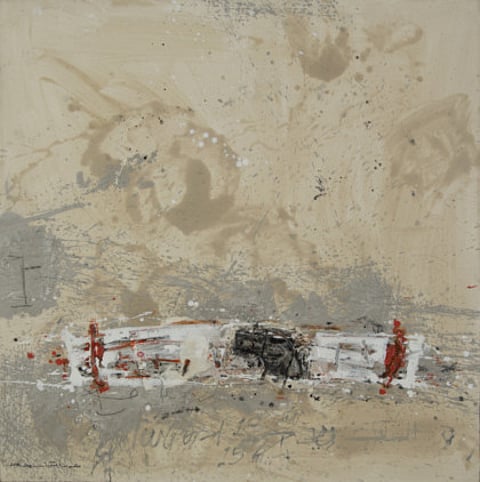Creations reflecting the conflict in Syria
Contemporary art in the country takes a different direction as five new-generation artists aim to keep the legacy intact amid the ruin

Ayyam Gallery’s latest show, “Syria’s Apex Generation”, puts the spotlight on a new school of Syrian painting that developed in Damascus, and continues to thrive despite the disintegration of the art scene in the city. The multiple-venue show, spread across Ayyam’s two spaces in Dubai and in Beirut features recent works by Nihad Al Turk, Abdul Karim Majdal Al Beik, Othman Mousa, Mohannad Orabi, and Kais Salman. It explores the myriad ways a new generation of artists is responding to the current conflict in Syria, marking a new phase in Syrian contemporary art. But it also looks at how these artists are carrying forward the legacy of the artists who shaped Syrian visual culture for over 60 years.
The five artists were brought together by the Shabab Ayyam incubator programme for young artists launched by Ayyam Gallery in Damascus in 2007 and became part of a tightly knit intellectual circle, which contributed to their artistic development. New York based art historian and curator of the show, Maymanah Farhat has been following their work for many years.
“These painters began their careers in the 2000s, when Syrian art was going through a phase of rapid growth. I call them the Apex generation because they were leading this new school of painting and were a significant part of the Damascus art scene as it scaled new heights just before the war broke out. Although they have been forced to relocate to other cities such as Beirut, Cairo and Dubai, they remain close and they continue to create works linked by artistic threads that emerged during their early days together. Today, when a lot of Syrian art is focused on digital media and graphic art, this show highlights the fact that Syrian painting has a rich history and is surviving and thriving despite the conflict,” Farhat says.
The publication accompanying the show, places the recent work of these artists in the context of the broader history of modern and contemporary Syrian painting. “Syrian artists, especially painters have always addressed socio-political issues in their paintings through subtle allegory, satire, symbolism or expressionism. These young artists are following in the footsteps of great modernists such as Louay Kayyali and Fateh Moudarres and contemporary painters such as Moustafa Fathi, Saad Yagan and Safwan Dahoul, who advocated the social relevance of art, and amended the symbolism and content in their work to reflect intense situations in the country,” Farhat says.
The show highlights the fact that each artist has a distinct style, and has responded to his environment in a different way. The paintings have been arranged chronologically, allowing viewers to observe the changes in their work since the beginning of the uprising in 2011 to the present.
Al Turk’s mixed media paintings continue the tradition established by Syrian artists in the 1980s and 1990s of using deformed figures to reflect the turbulence in society. His layered, allegorical self-portraits from 2011, such as “Isolation” and “Dialogue” convey the darkness and depression within and all around him. But the mood is quite different in more recent works created after he moved to Beirut. The dark colours of the past have been replaced by a new palette of bright colours, and the figures are no longer deformed as they finally escape the weight of the world.
Al Beik is known for using materials such as charcoal, plaster, starch, ash and burlap to recreate the look of the weathered walls of Damascus in his large scale mixed media paintings. The cracks, graffiti and markings on these deteriorating surfaces are presented as records of the passage of time and of the history and changing culture of the city. But since the conflict began, he has been covering his canvases with burn marks and cuts, repaired with rough stitches, as well as found objects such as fabric strips, guns, knives, crosses and bird traps that comment on the challenges of life under conflict.
Mousa’s early still life paintings are simply an exploration of the beauty in the most mundane things. But in his recent work everyday objects such as food, toys and paint tubes are transformed into weapons, reflecting the ever present danger and violence in the daily lives of ordinary Syrians. In another series of satirical still life paintings the artist portrays the thrones of absent monarchs, stripping these symbols of power of their aura with his absurd and humorous compositions.
Orabi’s whimsical self portraits, dominated by vivacious, androgynous childlike figures in various scenarios reveal his fascination with the evolution of consciousness in childhood. But, since the uprising began, his portraits have become more realistic, drawing inspiration from media coverage of the war. In his recent series titled, “It’s no longer about me”, he has used posters of martyrs, Facebook profile pictures and references to Cairo, where he moved, to create portraits of Syrians under siege, displaced and in exile, thus commenting on the human aspect of this political and ideological conflict.
Salman uses satire to comment on the greed, vanity and ideological extremism that has become a part of modern society. The exaggerated figures and mangled objects in his compositions reflect the psychological impact of elements such as terrorism, consumerism, cosmetic surgery, religious fanaticism, imperialism and voyeurism of the digital age that are being rationalised and accepted as normal by societies. His recent paintings depict the pain and violence of war and have symbolic references to foreign interference in the conflict and the biased international coverage of it.
“Syria’s Apex Generation” will run at Ayyam Gallery DIFC and Al Serkal Avenue until August 2.
Sign up for the Daily Briefing
Get the latest news and updates straight to your inbox



